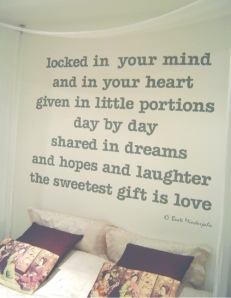Balance can be described as the equal distribution of visual weight in a room. An object’s visual weight is the amount of space it appears to occupy. A well-balanced room gives careful consideration to the placement of objects. The relationship between them, their colour, form, texture, pattern, and light are important aspects to achieve a great look and a feeling of completion. In a room the mere arrangement of fireplace, doors, windows etc. can create the balance already. Unbalanced rooms create discomfort.
There are three styles of balance: symmetrical, asymmetrical, and radial.
Symmetrical balance is usually found in more traditional interiors. Symmetrical balance is characterized by the same objects repeated in the same positions on either side of a vertical axis, for example in bedrooms, where both sides of the bed have the same night tables, lights, chairs etc. Symmetry is a good way to achieve a sense of order and is often used, when formal effects are wanted, when focusing attention on something important is desirable, when the use of the room suggests symmetry or when contrast with natural surroundings is sought.

Example for a symmetrical balanced bedroom
Asymmetrical balance is often used in modern designs to create more lively interiors. Here balance is achieved with some dissimilar objects that have equal visual weight or eye attraction. Asymmetrical balance is more casual, but more difficult to create, because it suggests movement, spontaneity and informality. It is less obvious than the formality of symmetry and allows full freedom and flexibility in arrangements for utility as well as for beauty and individuality.

Example for an asymmetrical balanced bedroom
Radial symmetry is when all the elements of a design are arrayed around a center point, as in the spokes of a wheel or the petals of a daisy. Its chief characteristic is a circular movement out from, toward or around a centre. In homes it is found mainly in circular dining settings or spiral staircases. Though not so often employed in interiors, radial symmetry can provide an interesting counterpoint if used appropriately.

Example for a radial balanced dining room
Personal Note: “I hope you’ll enjoy my Blog and the new topic “Interior Design”. In my next Interior blog I will write about the second principle “Emphasis”.
Last night I went to a Halloween Party with the theme “Rocky Horror Picture Show”. That was the craziest and most bizarre costume party I ever went to….
Later today we will go to a park and have a “Halloween Picnic” with the kids and lots of families and lots of lollies. Fingers crossed, that the sun stays with us!
So, stay tuned and have a happy and wonderful day!” Beate
Tags: asymmetric, Balance, circular, Design, formal, Interior Design, Interiors, modern, movement, Principles, Symmetry, visual weight

















